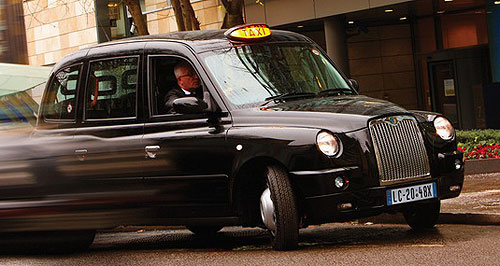News - General NewsLondon Taxi eyes Australian marketAdvance Australian fare: The London Taxi Company is currently carrying out ‘due diligence’ on bringing the TX4 to Australia, with an import deal set to be announced soon. Iconic British cab could call Australia home as London Taxi Co closes in on deal1 Oct 2012 By TERRY MARTIN THE London Taxi Company is working on a plan to bring its iconic ‘black cab’ to Australia. Responding to GoAuto’s recent article on the Australian taxi industry which indicated that purpose-built taxis were not on the agenda here – despite calls for such vehicles from the industry and an independent inquiry – The London Taxi Company has revealed that it is working on a plan to bring the current TX4 model to Australia. “We are currently carrying out due diligence to bring our current model, the TX4 London Taxi, to Australia and hope to make an official announcement shortly,” the company’s international marketing manager Maria Holmes-Keeling told GoAuto. Billed as “the only full accessible, purpose-built taxi in the world designed for drivers and a wide range of passengers”, the wheelchair-accessible TX4 was launched in 2006 and is currently produced in both the UK and China, the latter under a joint venture created in 2007 between London Taxis’ parent Manganese Bronze Holdings and Geely Automobile Holdings. The TX4 is sold in China under Geely’s Englon brand, and the joint-venture operation, known as Shanghai LTI, supplies TX4 components for Manganese Bronze’s UK manufacturing facilities and also produces the vehicle for international sale.  Left: Geely Englon TX4 taxi. Left: Geely Englon TX4 taxi.It is likely that the Australian-bound taxis would be produced in China, although this is still to be confirmed. The local distribution arrangements and other details of the impending deal are also still under wraps. Ms Holmes-Keeling said the Australian distributor of Geely vehicles, Chinese Automotive Distributors, “are official dealers for Geely vehicles only and are not able to comment regarding sales of the TX4”. A successor to the TXII, the TX4 blends the classic London Taxi retro styling with excellent accessibility, a spacious and comfortable cabin and driver safety and security, the latter with a specially constructed “attack resistance centre”. The door apertures are wide enough for wheelchair access and egress, while standard features include an integrated wheelchair ramp and securing facility, a swivel seat to aid passengers with mobility impairment, an induction loop for people with hearing impairment, and brightly coloured and large grabhandles that are particularly suitable for passengers with either a visual impairment or arthritis. The TX4 is available internationally with a choice of diesel or petrol engine power, the former a VM Motori-sourced 75kW/240Nm 2.5-litre common-rail four-cylinder turbo-diesel and the latter a Mitsubishi-sourced 112kW/212Nm 2.4-litre four-cylinder unit. The diesel engine is available with either a five-speed manual or five-speed automatic transmission, while the petrol engine is paired solely with a five-speed manual gearbox. With a kerb weight ranging from 1815-1975kg, the Euro 4-compliant diesel-powered TX4 returns combined-cycle fuel economy of 8.0L/100km (auto: 8.8) and CO2 emissions of 211g/km (auto: 233), while the petrol version returns 10.9L/100km and 256g/km. The taxi is built on a 2886mm wheelbase and measures 4580mm long, 2036mm wide and 1834mm high. A ladder-frame chassis and separate body construction is used and the suspension set-up is an independent double wishbone arrangement at the front, while at the rear there is a solid axle with coil springs and Panhard rod. It uses front disc brakes and rear drums brakes and 16-inch wheels, while the power-assisted steering offers a maximum turning distance of 8.53m (between walls). Indeed, the tight turning circle is one of the key selling points of the vehicle. As well as operating in the UK and China, the TX4 is currently in service in various locations around the globe, from the US and Europe to the Middle East and South Africa. The London Taxi Company was formerly known as London Taxis International (LTI) before it was rebranded in October 2010. A new model known as the TXN has also been developed but is still in the prototype stage.  Read more |
Click to shareGeneral News articlesResearch General News Motor industry news |















Facebook Twitter Instagram